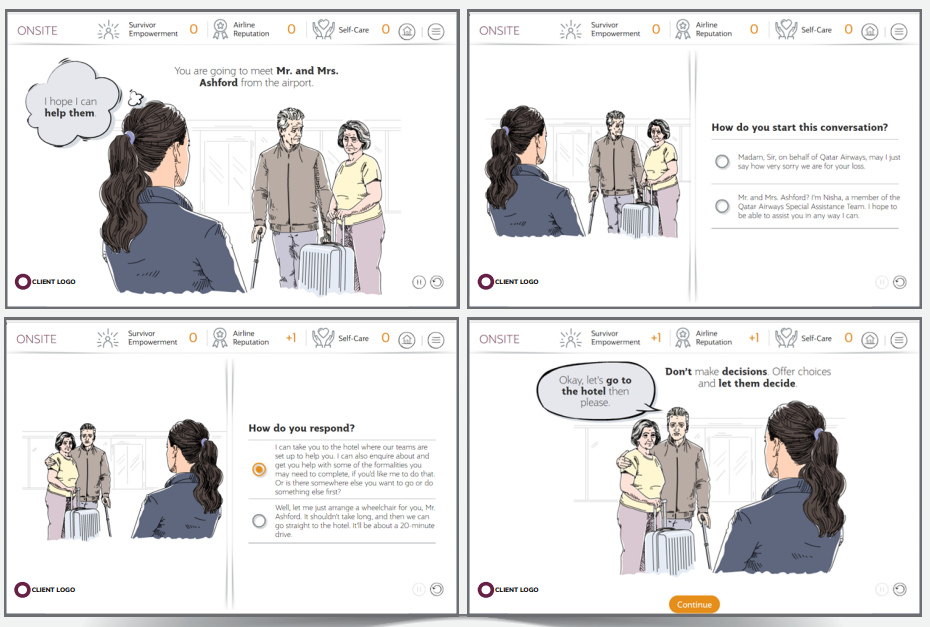Building on our prior dialogue on the types of scenarios and their ideal use-cases, in this blog we will focus on the realm of branching scenarios. These dynamic simulations, observed across diverse contexts, navigate complex decisions during critical incidents, showcasing their potential for skill development.
Branching scenarios provide rich practice in situations where more than one decision is embedded. In this case, it was about dealing with upset and emotional people under drastic circumstances. This is a classic situation where such scenarios provide safe practice before it matters, keeping skills active for an uncertain time of deployment. Let’s dive into a case study which uncovers the role of branching scenarios in shaping immersive learning experiences.
The context
As a major international airline, the client organization in picture (Name withheld) has a natural focus on safety and an enviable reputation. Regardless, accidents happen. When they do, how an organization responds is critical to maintaining a reputation for excellence.
In this case, there’s a Deployed Response Group, and as part of that group, a Special Assistance Team is responsible for dealing with victims’ families and the survivors. This is, not surprisingly, extremely sensitive work, and practice is critical to be prepared.
The underlying model is to empower the individuals to make choices, rather than do so for them. Thus, the goals are to help these people to:
- Express their emotions and needs
- Understand what is happening
- Understand what needs to be done
- Get access to information and people
- Know what options they have
- Feel connected
How is this to be done?
The solution
As part of a larger training, branching scenarios were seen to be the appropriate practice. The whole solution included, beyond the necessary content, knowledge checks to assure understanding, and then branching scenarios as practice across a variety of different families.
The use of multiple branching scenarios accomplished several goals. For one, it provided sufficient practice for this critical skill set. Second, it provided sufficient variety to allow individuals to abstract the underlying principles and develop a generalized understanding.

While the structures weren’t exactly as pictured, as this was pre-consultation with the client, they’re indicative of the structure. The scenarios used multiple forms of feedback. In addition to the dialog from the interactions, there was also body language portrayed. This reflects the clues that need to be assessed and used to determine courses of action.
The visual design was kept clean, with an emphasis on the people and the dialog, the critical elements. Other context was conveyed but muted. The result was a simple but critical visual approach.

The outcome
This program is used as a refresher after the training. An important result was that a majority of the attendees commented that the experience of the digital solution was exactly the same as they had received in the classroom session. It also won Brandon Hall Group HCM Excellence and LearnX awards.
The situation is an example of when learning isn’t known when it’ll be needed, but it’s absolutely important when it is. Thus, it needs to be kept active. Scenario-based learning here provides the necessary practice to keep active the necessary learnings so that if and when such skills are needed, they’re available.
In the realm of emotional support during critical incidents, branching scenarios prove invaluable for training, as seen in a major airline’s Special Assistance Team. This method immerses individuals in diverse scenarios, bridging theory and practice through nuanced visual design and realistic feedback. With accolades and positive feedback affirming its efficacy, scenario-based learning stands as a powerful tool to maintain and activate crucial skills. Explore its potential in our ebook,Scenario-Based Learning: The Ultimate Asset in Your L&D Toolkit and discover its impact on skill readiness.



















